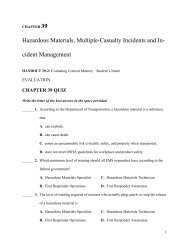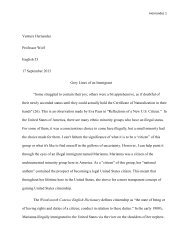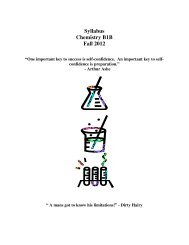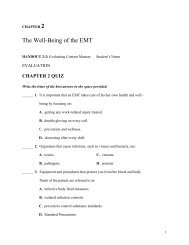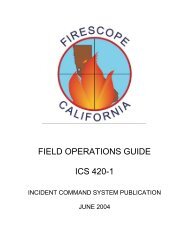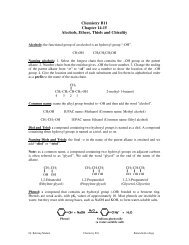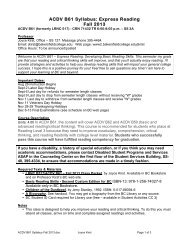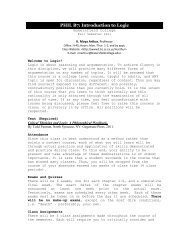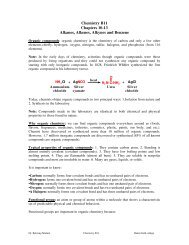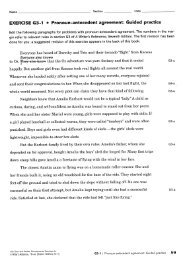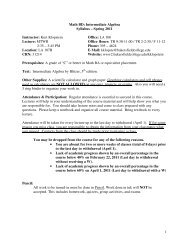20.26 a. fusion b. radioactive decay c. fission d. transmutation 20.28 ...
20.26 a. fusion b. radioactive decay c. fission d. transmutation 20.28 ...
20.26 a. fusion b. radioactive decay c. fission d. transmutation 20.28 ...
- No tags were found...
You also want an ePaper? Increase the reach of your titles
YUMPU automatically turns print PDFs into web optimized ePapers that Google loves.
<strong>20.26</strong>a. <strong>fusion</strong>b. <strong>radioactive</strong> <strong>decay</strong>c. <strong>fission</strong>d. <strong>transmutation</strong><strong>20.28</strong> The total amount of <strong>radioactive</strong> material at the start is 10 g Pu-239 + 10 g Np-239 = 20 gtotal. In order to reduce this by 50%, the total mass must be reduced to 10 g. Since the halflifeofPu-239 (2.4 x 10 4 years) is long compared to the half-life of Np-239 (2.4 days), all of theNp-239 will have decomposed before any measurable amount of Pu-239 <strong>decay</strong>s. This wouldrequire approximately 10 half-lives, or about 24 days.20.36.20.4220.4822688 Ra → 22286 Rn + 4 2 Hea. Ag does not have an atomic number that is a magic number of protons. Find thenumbers of neutrons in the two isotopes.10247Ag : No. of neutrons = 102 − 47 = 5510947Ag : No. of neutrons = 109 − 47 = 62Neither isotope has a magic number of neutrons, but 10947Ag has an even number ofneutrons, whereas 10247Ag has an odd number of neutrons. Because stable odd-oddnuclei are rare, 10910247Ag is expected to be stable and47Ag <strong>radioactive</strong>.b. Neither nucleus has a magic number of protons or neutrons. Of the two isotopes 25 Mg 12has an even number of protons and is close to the true atomic mass of magnesium,24.3050 amu. 2410Ne is not close to the true atomic mass of neon, 20.179 amu.Therefore, 252412Mg is expected to be stable and10Ne <strong>radioactive</strong>.c. No element with atomic number greater than 83 has a stable isotope. Thus, 22390Th is<strong>radioactive</strong>, and 203 81Tl is stable.d.e.147 N (n,p) 14 6 C636629Cu (α,n) Ga 31
20.54f.27Al + 3 H → 27Mg + AX13 1 12 ZFrom the superscripts: 27 + 3 = 27 + A, or A = 27 + 3 − 27 = 3; from the subscripts:13 + 1 = 12 + Z, or Z = 13 + 1 − 12 = 2. The ejected particle is 3 2X . The element withZ = 2 is helium, so the missing nuclide is 3 He . 2g. The reaction may be written126 C + 3 1 H → 146 C + AZ XFrom the superscripts: 12 + 3 = 14 + A, or A = 12 + 3 − 14 = 1; from the subscripts:6 + 1 = 6 + Z, or Z = 6 + 1 − 6 = 1. The ejected particle is 1 1X . The element with Z = 1is hydrogen, so the missing nuclide is 1 1H , or p. The reaction is then written126 C ( 3 1 H ,p) 14 6 C20.60. Find the rate of <strong>decay</strong> from the activity.Rate = 45.3 Ci x103.700 x 10 nuclei / s1 Ci= 1.6761 x 10 12 nuclei/sConvert the mass of the Na-24 to the number of nuclei. The molar mass in grams isapproximately equal to the mass number.5.2 x 10 −6 g Na-24 x1 mol Na-2424 g Na-24x236.02 x 10 nuclei1 mol Na-24= 1.304 x 10 17 nucleiSolve the rate equation for k and substitute.k = rateN t=121.6761 x 10 nuclei/s171.304 x 10 nuclei= 1.285 x 10 −5 = 1.3 x 10 −5 /s20.70. Substituting for k = 0.693/t 1/2 givesNt olnN = −kt = -0.693 tt1/2=-0.693 (7.0 d)8.07 d= −0.6011Taking the antilog of both sides of this equation givesNtN = e−0.6011 = 0.5481oAfter 7.0 days, 54.8% of the I-131 remains; therefore, the mass of I-131 remaining is2.5 µg I-131 x 0.5481 = 1.37 = 1.4 µg I-131
20.82. First, determine the nuclear mass of 2 1 H .Nuclear mass of 2 1H = 2.01400 amu − 0.000549 amu = 2.013451 amuWrite the appropriate nuclear mass below each nuclide symbol, and calculate ∆m.11 H +1 1 H → 2 1 H + 01 eMasses: 1.00728 1.00728 2.013451 0.000549 amu∆m = [2.013451 + 0.000549 − (2 x 1.00728)] amu = −0.000560 amuThe energy change for 1 mol is∆E = (∆m)c 2 = (−5.6 x 10 −7 kg)(3.00 x 10 8 m/s) 2 = −5.04 x 10 10 kg•m 2 /s 2 = −5.0 x10 10 JFinally, calculate the energy change for one 1 1 H nucleus.10-5.04 x 10 J1 mol1 molx236.022 x 10 nuclei1 MeVx-131.602 x 10 J= −0.522 = −0.52 MeV20.94. Use the equation for the number of nuclei in a sample after a time, t.Nt olnN = -0.693 tt1/2Rearrange this to give an expression for t.t1/2Nt = lno0.693 NtThe amount of Rb-87 initially present is the amount remaining plus the amount converted toSr-87. Therefore,NNot102.1 µ g + 5.3µg=102.1 µ gThe age of the rock is= 1.052t =104.8 x 10 yln (1.052) = 3.51 x 10 90.693= 3.5 x 10 9 y
20.98 First, determine the nuclear mass of 4 2 He .20.102Nuclear mass of 4 2He = 4.00260 amu − (2 x 0.000549 amu) = 4.001502 amuWrite the appropriate nuclear mass below each nuclide symbol, and calculate ∆m.4 1 H→ +4 He1 22 0 e 1Masses: 1.00728 4.001502 0.000549 amu∆m = [4.001502 + (2 x 0.000549) − (4 x 1.00728)] amu = −0.026520 amuWhen 4 mol 1 1 H are fused, the change in mass is −0.026520 g. Therefore, for 1.00 kg 1 1 H ,the mass change is1.00 x 10 3 g x1 mol H1.00728 g H x -0.026520 g14 mol H = −6.5820 g1111Converting mass to energy gives∆E = (∆m)c 2 = (−6.5820 x 10 −3 kg)(2.998 x 10 8 m/s) 2= −5.9159 x 10 14 = −5.92 x 10 14 J (−5.92 x 10 11 kJ)For the combustion of carbon:∆H foC(graphite) + O 2 (g) → CO 2 (g)0 0For the reaction, ∆H = ∆E = −394 kJ/mol.1.00 x 10 3 g x1-394 kJ/mol1 mol C12.01 g C x -394 kJ1 mol C = −3.280 x 104 = −3.28 x 10 4 kJThe energy released in the <strong>fusion</strong> of 1.00 kg of 1 1 H is 5.92 x 1011 kJ, which is several ordersof magnitude larger than the energy released in the combustion of 1.00 kg of C (3.28 x 10 4kJ).a.13252 Te → 13254 Xe + 2 0-1 βb. H 213252 Te (g) → H 2 +13254 Xec. Use the rate law to find the fraction remaining. The time is 99.0 h, and the half-life is3.26 d. Substituting yieldsNt olnN = −kt = -0.693 tt1/2Taking the antilog of each side givesNtN = too=AA = e−0.87687 = 0.41607-0.693 (99.0 h)3.26 dTherefore, the number of moles remaining after 99.0 h isA t = 0.0125 mol x 0.41607 = 0.0052009 molx1 d24 h = −0.87687
The reaction can be summarized as follows:H 2 Te → H 2 + Xe0.0125 - y y y20.120 First, determine the mass of radium-226 nuclei in 543.0 mg of RaBr 2 .0.5430 g RaBr 2 x226 g Ra385.8 g RaBr2= 0.31808 g Ra-226Use the rate law to find the fraction of radium-226 that <strong>decay</strong>ed. The time is 37.5 y, and thehalf-life is 1602 y. Substituting yieldsN tlnN = −kt = -0.693 tot1/2=-0.693 (37.5 y)1602 y= −0.016221Take the antilog of each side to get the fraction of radium-226 remaining.N tN = AoAot= e −0.016221 = 0.983908Thus, the fraction of radium-226 that <strong>decay</strong>ed is 1 − 0.983908 = 0.016091. This can now beconverted to moles of radon-222 formed.0.31808 g Ra x 0.016091 x1 mol Ra226 g Rax1 mol Rn1 mol RaNow calculate the volume of Rn at 23°C and 785 mmHg.= 2.264 x 10 −5 mol RnV = nRTP=-5(2.264 x 10 mol)(0.0821 L • atm/(K • mol)(296 K)(785/760) atm= 5.328 x 10 −4 L = = 5.33 x 10 −4 L = 0.533 mL



